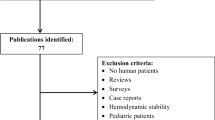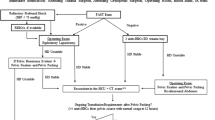Abstract
Background
Preperitoneal packing (PPP) has been widely accepted as a damage control technique for severe bleeding from pelvic fractures. It is supposed to work by direct compression and tamponade of the bleeding source in the pelvis and it has been suggested to be effective for both venous and arterial bleeding. However, there is little evidence to support its efficacy or the ability to place the laparotomy pads in proximity of the desired location.
Methods
Bilateral PPP was performed on 10 fresh human cadavers, followed by laparotomy and measurements of resultant pad placement in relation to critical anatomic structures.
Results
A total of 20 assessments of laparotomy pad placement were performed. Following completion of PPP, a midline laparotomy was performed to determine proximity and closest distance of the laparotomy pads to sites of potential bleeding in pelvic fractures. In almost all cases, the pad placement was not contiguous with the key anatomic structure with mean placement 3.9 + 1.1 cm from the sacroiliac joint, 3.5 + 1.6 cm from the common iliac artery, 1.1 + 1.2 cm from the external iliac artery, 2.8 + 0.8 cm from the internal iliac artery, and 2.3 + 1.2 cm from the iliac bifurcation. Surgeon experience resulted in improved placement relative to the sacroiliac joint, however the pads still did not directly contact the target point.
Conclusion
This human cadaver study has shown that PPP, even in experienced hands, may not be placed in significant proximity of anatomical structures of interest. The role of PPP needs to be revisited with better clinical or human cadaver studies.

Similar content being viewed by others
References:
Smith WR, Moore EE, Osborn P et al (2005) Retroperitoneal packing as a resuscitation technique for hemodynamically unstable patients with pelvic fractures: report of two representative cases and a description of technique. J Trauma 59(6):1510–1514
Tscherne H, Pohlemann T, Gansslen A, Hufner T, Pape HC (2000) Crush injuries of the pelvis. Eur J Surg 166(4):276–282
Coccolini F, Stahel PF, Montori G et al (2017) Pelvic trauma: WSES classification and guidelines. World J Emerg Surg 12:5
Bugaev N, Rattan R, Goodman M et al (2020) Preperitoneal packing for pelvic fracture-associated hemorrhage: a systematic review, meta-analysis, and practice management guideline from the Eastern Association for the Surgery of Trauma. Am J Surg 220(4):873–888
Magnone S, Coccolini F, Manfredi R et al (2014) Management of hemodynamically unstable pelvic trauma: results of the first Italian consensus conference (cooperative guidelines of the Italian Society of Surgery, the Italian Association of Hospital Surgeons, the Multi-specialist Italian Society of Young Surgeons, the Italian Society of Emergency Surgery and Trauma, the Italian Society of Anesthesia, Analgesia, Resuscitation and Intensive Care, the Italian Society of Orthopaedics and Traumatology, the Italian Society of Emergency Medicine, the Italian Society of Medical Radiology -Section of Vascular and Interventional Radiology- and the World Society of Emergency Surgery). World J Emerg Surg 9(1):18
Cothren CC, Osborn PM, Moore EE, Morgan SJ, Johnson JL, Smith WR (2007) Preperitonal pelvic packing for hemodynamically unstable pelvic fractures: a paradigm shift. J Trauma 62(4):834–839
Costantini TW, Coimbra R, Holcomb JB et al (2016) Current management of hemorrhage from severe pelvic fractures: results of an American Association for the Surgery of Trauma multi-institutional trial. J Trauma Acute Care Surg 80(5):717–723
Burlew CC, Moore EE, Stahel PF et al (2017) Preperitoneal pelvic packing reduces mortality in patients with life-threatening hemorrhage due to unstable pelvic fractures. J Trauma Acute Care Surg 82(2):233–242
Osborn PM, Smith WR, Moore EE et al (2009) Direct retroperitoneal pelvic packing versus pelvic angiography: a comparison of two management protocols for haemodynamically unstable pelvic fractures. Injury 40(1):54–60
Jang JY, Shim H, Jung PY, Kim S, Bae KS (2016) Preperitoneal pelvic packing in patients with hemodynamic instability due to severe pelvic fracture: early experience in a Korean trauma center. Scand J Trauma Resusc Emerg Med 24:3
Ron G, Epstein D, Ben-Galim P, Klein Y, Kaban A, Sagiv S (2015) Extra-peritoneal pressure packing without external pelvic fixation: a life-saving stand-alone surgical treatment. J Emerg Trauma Shock 8(4):181–187
McDonogh JM, Lewis DP, Tarrant SM, Balogh ZJ (2022) Preperitoneal packing versus angioembolization for the initial management of hemodynamically unstable pelvic fracture: a systematic review and meta-analysis. J Trauma Acute Care Surg 92(5):931–939
Stahel PF, Mauffrey C, Smith WD, McKean J, Hao J, Burlew CC et al (2013) External fixation for acute pelvic ring injuries: decision making and technical options. J Trauma Acute Care Surg 75(5):882–887
Cho J, Benjamin E, Inaba K, Lam L, Demetriades D (2018) Severe bleeding in pelvic fractures: considerations in planning damage control. Am Surg 84(2):267–272
Sato Y, Sekine K, Shibusawa T et al (2017) Effect of retroperitoneal pelvic packing on pelvic cavity pressure: a cadaveric study. Orthopedics 40(6):e947–e951
Sandhu J, Abrahams R, Miller Z, Bhatia S, Zakrison TL, Mohan P (2020) Pelvic Trauma: factors predicting arterial hemorrhage and the role of Angiography and preperitoneal pelvic packing. Eur Radiol 30(11):6376–6383
Tesoriero RB, Bruns BR, Narayan M et al (2017) Angiographic embolization for hemorrhage following pelvic fracture: Is it “time” for a paradigm shift? J Trauma Acute Care Surg 82(1):18–26
Surgeons ACo. Resources for Optimal Care of the Injured Patient. Chicago, IL: American College of Surgeons; 2022.
Heelan AA, Freedberg M, Moore EE et al (2020) Worth looking! venous thromboembolism in patients who undergo preperitoneal pelvic packing warrants screening duplex. Am J Surg 220(6):1395–1399
Author information
Authors and Affiliations
Corresponding author
Additional information
Publisher's Note
Springer Nature remains neutral with regard to jurisdictional claims in published maps and institutional affiliations.
Rights and permissions
Springer Nature or its licensor (e.g. a society or other partner) holds exclusive rights to this article under a publishing agreement with the author(s) or other rightsholder(s); author self-archiving of the accepted manuscript version of this article is solely governed by the terms of such publishing agreement and applicable law.
About this article
Cite this article
Benjamin, E.R., Warriner, Z. & Demetriades, D. Preperitoneal Packing for Pelvic Fracture Bleeding Control: A Human Cadaver Study. World J Surg 47, 621–626 (2023). https://doi.org/10.1007/s00268-022-06859-5
Accepted:
Published:
Issue Date:
DOI: https://doi.org/10.1007/s00268-022-06859-5




